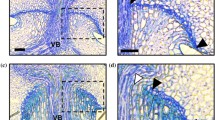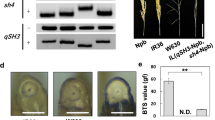Abstract
Seed shattering is an important trait that distinguishes domesticated plants from their wild and weedy counterparts. This trait is essential for seed harvesting in the production of cereal crops, and therefore has attracted great attention of scientists to study the underlying genetic mechanisms of seed persistence/shattering during crop domestication. To study seed shattering in weedy rice, we analyzed the F2 offspring derived from artificial crosses between a non-shattering rice variety Minghui86 and a weedy rice accession WD1292 with strong seed shattering. We identified three seed-shattering associated quantitative trait loci (QTL), wd-qsh1, wd-qsh3, and wd-qsh5 located on chromosome-1, -3 and -5, respectively, based on the microsatellite (SSR) variation pattern of the crop-weed F2 offspring. The wd-qsh3 had the greatest contribution to seed shattering by explaining 31.41 % of the phenotypic variance, and the two remaining QTLs had relatively minor effects on phenotypic variation, ranging from 11.61 to 16.85 %. Comparative analysis indicated that the mapped QTLs (wd-qsh1, wd-qsh3 and wd-qsh5) from this study had no overlaps with any of the previously reported major shattering loci (e.g., SH4, qSH1, sh-h, and SHAT1) identified using a diverse set of rice germplasm, including cultivated, wild, and weedy rice lines. These results suggest that distinct genetic mechanisms should be evolved independently in different weedy rice groups, which allows weedy rice to adapt to the diverse agricultural environments. De-domestication plays a significant role in generating weedy rice without the involvement of wild rice in agro-ecosystems.





Similar content being viewed by others
References
Bres-Patry C, Lorieux M, Clément G, Bangratz M, Ghesquière A (2001) Heredity and genetic mapping of domestication-related traits in a temperate japonica weedy rice. Theor Appl Genet 102:118–126
Cai HW, Morishima H (2000) Genomic regions affecting seeds shattering and seeds dormancy in rice. Theor Appl Genet 100:840–846
Cao QJ, Xia H, Yang X, Lu BR (2009) Performance of hybrids between weedy rice and insect-resistant transgenic rice under field experiments: implication for environmental biosafety assessment. J Integr Plant Biol 51:1138–1148
Delouche JC, Burgos NR, Gealy DR, Zorilla-San MG, Labrada R, Larinde M, Rosell C (2007) Weedy rices: origin, biology, ecology and control. FAO of the United Nations, Rome
Doebley J (2006) Unfallen grains: how ancient farmers turned weeds into crops. Science 312:1318–1319
Estorninos LE Jr, Gealy DR, Gbur EE, Talbert RE, McClelland MR (2005) Rice and red rice interference. II. Rice response to population densities of three red rice (Oryza sativa) ecotypes. Weed Sci 53:683–689
Fukuta Y, Yagi T (1998) Mapping of a shattering resistance gene in a mutant line SR–5 induced from an indica rice variety, Nan–jing11. Breed Sci 48:345–348
Gealy DR, Tai TH, Sneller CH (2002) Identification of red rice, rice, and hybrid populations using microsatellite markers. Weed Sci 50:333–339
Grimm A, Fogliatto S, Nick P, Ferrero A, Vidotto F (2013) Microsatellite markers reveal multiple origins for Italian weedy rice. Ecol Evol 14:4786–4798
Gross BL, Steffen FT, Olsen KM (2010) The molecular basis of white pericarps in African domesticated rice: novel mutations at the Rc gene. J Evol Biol 23:2747–2753
Gu XY, Kianian SF, Hareland GA, Hoffer BL, Foley ME (2005) Genetic analysis of adaptive syndromes interrelated with seed dormancy in weedy rice (Oryza sativa). Theor Appl Genet 110:1108–1118
He ZX, Jiang XQ, Ratnasekera D, Grassi F, Perera U, Lu B-R (2014) Seed-mediated gene flow promotes genetic diversity of weedy rice within populations: Implications for weed management. PLoS ONE 9(12):e112778. doi:10.1371/journal.pone.0112778
Htun TM, Chizuru Inoue C, Orn Chhourn O, Ishii T, Ishikawa R (2014) Effect of quantitative trait loci for seed shattering on abscission layer formation in Asian wild rice Oryza rufipogon. Breed Sci 64:199–205
Ishikawa R, Thanh PT, Nimura N, Htun TM, Yamasaki M, Ishii T (2010) Allelic interaction at seed-shattering loci in the genetic backgrounds of wild and cultivated rice species. Genes Genet Syst 85:265–271
Ji H, Kim SR, Kim YH, Kim H, Eun MY, Jin ID, Cha YS, Yun DW, Ahn BO, Lee MC, Lee GS, Yoon UH, Lee JS, Lee YH, Suh SC, Jiang WZ, Yang JI, Jin P, McCouch SR, An G, Koh HJ (2010) Inactivation of the CTD phosphatase-like gene OsCPL1 enhances the development of the abscission layer and seeds shattering in rice. Plant J 61:96–106
Kim HY (1986) Studies on the genetic analysis and selection efficiency for grain shattering in rice (Oryza sativa L.) II. Res Rep Rural Dev Adm, Crop Korea Repub 28:49–72
Konishi S, Izawa T, Lin SY, Ebana K, Fukuta Y, Sasaki T, Yano M (2006) An SNP caused loss of seeds shattering during rice domestication. Science 312:1392–1396
Lee SJ, Oh CS, Suh JP, McCouch SR, Ahn SN (2005) Identification of QTLs for domestication-related and agronomic traits in an Oryza sativa × O. rufipogon BC1F7 population. Plant Breed 124:209–219
Li WL, Gill BS (2006) Multiple genetic pathways for seeds shattering in the grasses. Funct Integr Genomic 6:300–309
Li C, Zhou A, Sang T (2006) Rice domestication by reducing shattering. Science 311:1936–1939
Lin Z, Griffith ME, Li X, Zhu Z, Tan L, Fu Y, Zhang W, Wang X, Xie D, Sun C (2007) Origin of seed shattering in rice (Oryza sativa L.). Planta 226:11–20
Londo JP, Schaal BA (2007) Origins and population genetics of weedy red rice in the USA. Mol Ecol 16:4523–4535
McCouch SR, Cho YG, Yano M, Paul E, Blinstrub M (1997) Report on QTL nomenclature. Rice Genet Newsl 14:11–13
Onishi K, Takagi K, Kontani M, Tanaka T, Sano Y (2007) Different patterns of genealogical relationships found in the two major QTLs causing reduction of seed shattering during rice domestication. Genome 50:757–766
Purugganan MD, Fuller DQ (2009) The nature of selection during plant domestication. Nature 457:843–848
Qin Y, Kim SM, Zhao XH, Jia BY, Lee HS, Kim KM, Eun MY, Jin ID, Sohn JK (2010) Identification for quantitative trait loci controlling grain shattering in rice. Genes Genom 32:173–180
Reagon M, Thurber CS, Gross BL, Olsen KM, Jia YL, Caicedo AL (2010) Genomic patterns of nucleotide diversity in divergent populations of US weedy rice. BMC Evol Biol 10:180
Saghai-Maroof MA, Soliman KM, Jorgensen RA, Allard RW (1984) Ribosomal DNA spacer-length polymorphisms in barley: Mendelian inheritance, chromosomal location, and population dynamics. P Natl Acad Sci USA 81:8014–8018
Subudhi PK, Singh PK, DeLeon T, Parco A, Karan R, Biradar H, Cohn MA, Sasaki T (2014) Mapping of seeds shattering loci provides insights into origin of weedy rice and rice domestication. J Hered 105:276–287
Thomson MJ, Tai TH, McClung AM, Lai XH, Hinga ME, Lobos KB, Xu Y, Martinez CP, McCouch SR (2003) Mapping quantitative trait loci for yield, yield components and morphological traits in an advanced backcross population between Oryza rufipogon and the Oryza sativa cultivar Jefferson. Theor Appl Genet 107:479–493
Thurber CS, Reagon M, Gross BL, Olsen KM, Jia Y, Caicedo AL (2010) Molecular evolution of shattering loci in US weedy rice. Mol Ecol 19:3271–3284
Thurber CS, Jia MH, Jia YL, Caicedo AL (2013) Similar traits, different genes? Examining convergent evolution in related weedy rice populations. Mol Ecol 22:685–698
Van Ooijen JW (2006) JoinMap4, software for the calculation of genetic linkage maps in experimental population. Kyazma BV, Wageningen
Van Ooijen JW (2009) Software for the mapping of quantitative trait loci in experimental populations of diploid species. Kyazma BV, Wageningen
Wang W, Xia H, Yang X, Xu T, Si HJ, Cai XX, Wang F, Su J, Snow AA, Lu B-R (2014) A novel 5-enolpyruvoylshikimate-3-phosphate (EPSP) synthase transgene for glyphosate resistance stimulates growth and fecundity in weedy rice (Oryza sativa) without herbicide. New Phytol 202:679–688
Xia HB, Xia H, Ellstrand NC, Yang C, Lu B-R (2011a) Rapid evolutionary divergence and ecotypic diversification of germination behavior in weedy rice populations. New Phytol 191:1119–1127
Xia HB, Wang W, Xia H, Zhao W, Lu B-R (2011b) Conspecific crop-weed introgression influences evolution of weedy rice (Oryza sativa f. spontanea) across a geographical range. PLoS ONE 6:e16189
Xiong LZ, Liu KD, Dai XK, Xu CG, Zhang Q (1999) Identification of genetic factors controlling domestication-related traits of rice using an F2 population of a cross between Oryza sativa and Oryza rufipogon. Theor Appl Genet 98:243–251
Zhou Y, Lu DF, Li CY, Luo JH, Zhu BF, Zhu JJ, Shangguan YY, Wang ZX, Sang T, Zhou B, Han B (2012) Genetic control of seeds shattering in rice by the APETALA2 transcription factor SHATTERING ABORTION1. Plant Cell 24:1034–1048
Zhu YQ, Ellstrand NC, Lu BR (2012) Sequence polymorphisms in wild, weedy, and cultivated rice suggest seed-shattering locus sh4 played a minor role in Asian rice domestication. Ecol Evol 2:2106–2113
Acknowledgments
This study was funded by the “973” program (2011CB100401) and the Natural Science Foundation of China (31271683, 31330014).
Conflict of interest
The authors have no conflicts of interest to declare.
Author information
Authors and Affiliations
Corresponding authors
Electronic supplementary material
Below is the link to the electronic supplementary material.
10681_2014_1331_MOESM1_ESM.tif
Supplementary material 1 (TIFF 635 kb) Figure S1 The partial sequences of the SH4 gene in the sampled rice cultivar (Minghui86) and weedy rice (WD1292) parents. Sequence comparison demonstrates the identical mutational nucleotide (T) at the functional nucleotide polymorphism (FNP) site of the cultivar and weedy parents, as indicated by a grey box, suggesting that both parents are non-shattering type for the SH4 gene. The straight long-line represents the untranslated region of SH4. The black box at the right side of the long-line represents the first exon of SH4. The stripped box represents a part of intron. The broken lines indicate the compared region included in the partial sequences (ca. 240 bp). The method for sequencing the partial SH4 gene followed the description of Zhu et al. (2012)
Rights and permissions
About this article
Cite this article
Yao, N., Wang, L., Yan, H. et al. Mapping quantitative trait loci (QTL) determining seed-shattering in weedy rice: evolution of seed shattering in weedy rice through de-domestication. Euphytica 204, 513–522 (2015). https://doi.org/10.1007/s10681-014-1331-x
Received:
Accepted:
Published:
Issue Date:
DOI: https://doi.org/10.1007/s10681-014-1331-x




